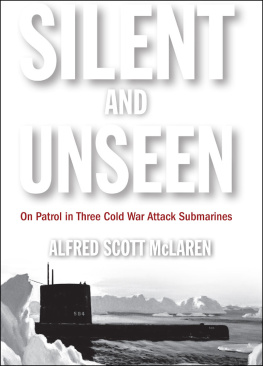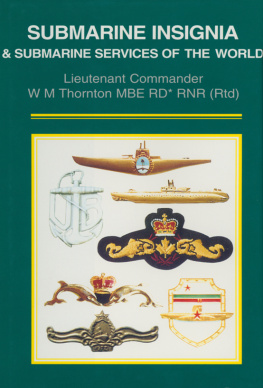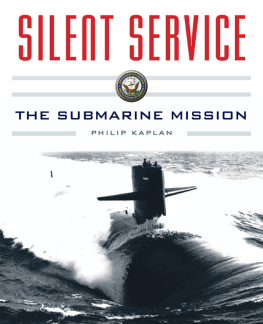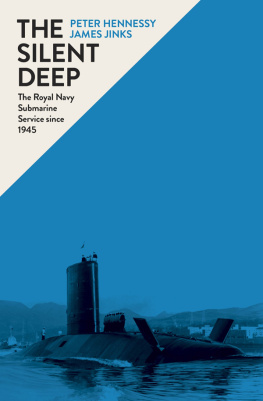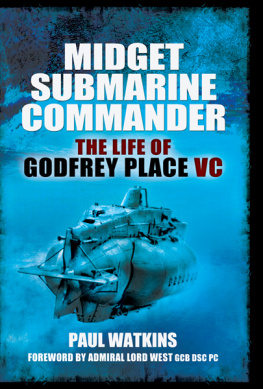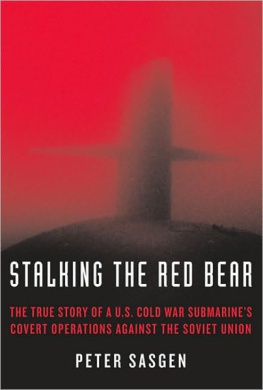
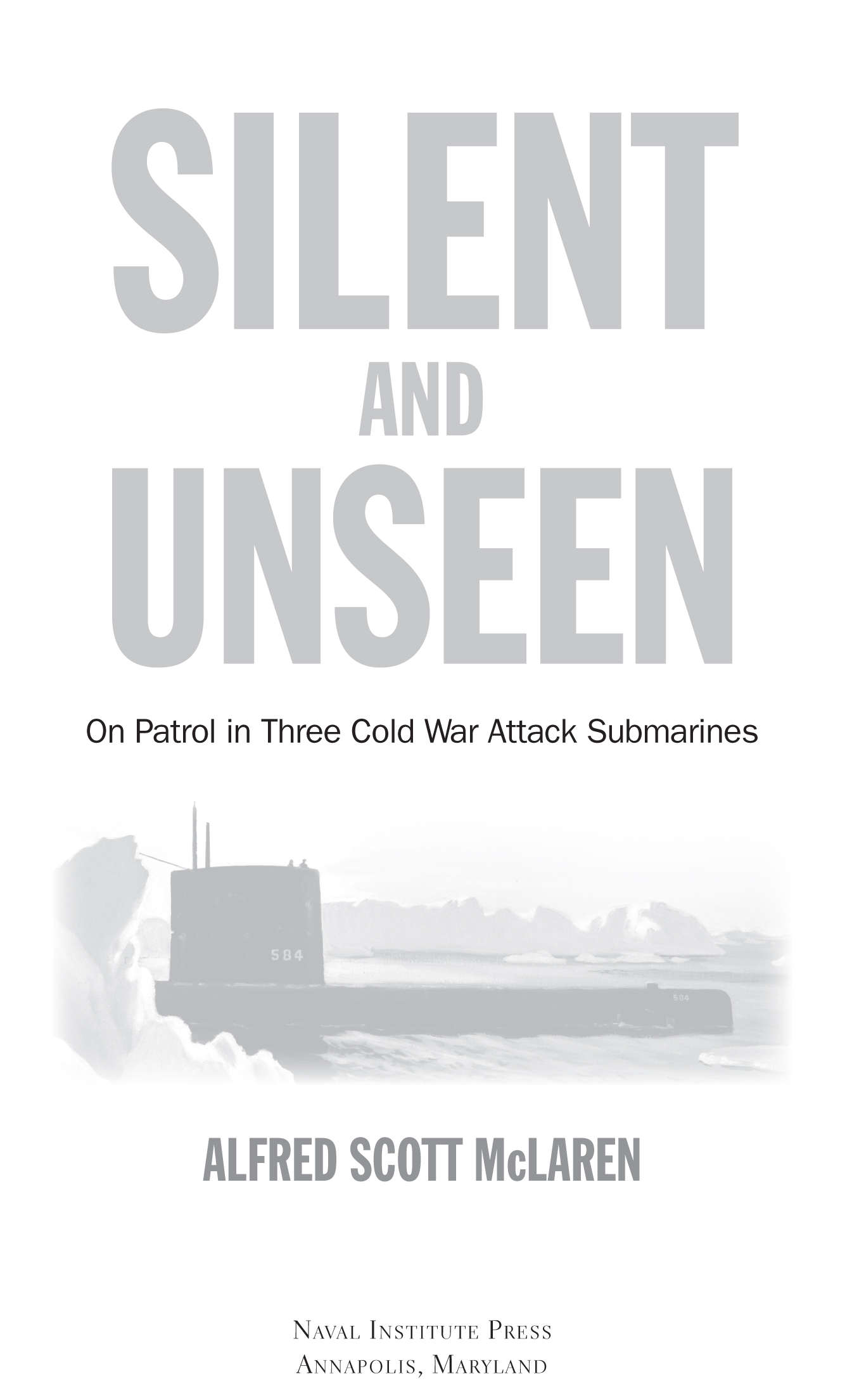
This book was brought to publication with generous assistance of Marguerite and Gerry Lenfest.
Naval Institute Press
291 Wood Road
Annapolis, MD 21402
2015 by Alfred Scott McLaren
All rights reserved. No part of this book may be reproduced or utilized in any form or by any means, electronic or mechanical, including photocopying and recording, or by any information storage and retrieval system, without permission in writing from the publisher.
Library of Congress Cataloging-in-Publication Data
McLaren, Alfred Scott.
Silent and unseen : on patrol in three Cold War attack submarines / Alfred Scott McLaren.
pages cm
Summary: Silent and Unseen is a memoir of a submariners life on a U.S. attack submarine during the Cold War by Capt. Alfred S. McLaren, an experienced submarine officer and nuclear attack submarine commander. He describes in riveting detail the significant events that occurred early in the Cold War during his seven years, 1958-1965, on board three attack submarines: the USS Greenfish (SS 351), USS Seadragon (SSN 584), and USS Skipjack (SSN 585). He took part in the first submerged transit of the Northwest Passage, a Baffin Bay expedition, and, as commander of USS Queenfish (SSN-651), a North Pole expedition that completed the first survey of the entire Siberian Continental Shelf Provided by publisher.
Includes bibliographical references and index.
ISBN 978-1-61251-846-6 (ebook) 1. McLaren, Alfred Scott. 2. United States. NavySubmarine forcesBiography. 3. United States. NavyOfficersBiography. 4. SubmarinersUnited StatesBiography. 5. Submarines (Ships)United StatesHistory20th century. 6. Seadragon (Submarine : SSN-584) 7. Skipjack (Submarine : SSN-585) 8. Greenfish (Submarine : SS-351) 9. United StatesHistory, Naval20th century. 10. Cold WarBiography. I. Title.
V63.M2867A3 2015
359.0092dc23
[B]
2015003774

 Print editions meet the requirements of ANSI/NISO z39.481992 (Permanence of Paper).
Print editions meet the requirements of ANSI/NISO z39.481992 (Permanence of Paper).
23 22 21 20 19 18 17 16 15 9 8 7 6 5 4 3 2 1
First printing
The USS Greenfish, USS Seadragon, and USS Skipjack insignias on pages 5, 63, and 139 are from the U.S. Navy.
To the officers and crews with whom I served on attack submarines during the Cold War and to all my brother submariners who served our great nation, silently and unseen, during this turbulent era.
Contents
I wish to acknowledge and thank, from the bottom of my heart, my wife of twenty-six wonderful years, Avery Battle Russell, for her loving and steadfast encouragement and support from the time I first began this book in 1996 until its completion in 2014. I also wish to thank her for her absolutely superb editorial advice and countless hours of editing during the course of preparing this book for publication.
Heartfelt thanks go to Ms. Wendy Gulley, archivist at the Submarine Force Museum and Library, Groton, Connecticut, for allowing me access to the submarine boat books, scrapbooks, and cruise books, and for her patient and invaluable assistance during a series of visits. I also thank Cdr. Don Ulmer and former Greenfish shipmate Jim Kyser for refreshing my memory with regard to Greenfishs maneuvering room and engineering spaces.
I also thank Lt. Cdr. Thomas J. Cutler, USN (Ret.), director of professional publishing at the Naval Institute Press, for his encouragement and sage advice as I pursued publication of this book. I further thank Marlena Montagna and Gary Thompsoneditorial assistant on the editorial staff of the Naval Institute Pressfor helping me bring this book to fruition. Finally, my heartfelt thanks go to Ms. Alison Hope for an extremely thorough and invaluable copy edit of my original manuscript.
In conclusion, I thank my former wife, the late Mary Louise Eisenhower, and my children for their loyal and steadfast support in holding down the home front during the many, many months I spent at sea and away from home on board three Cold War attack submarines: USS Greenfish, USS Seadragon, and USS Skipjack.
M y first book, Unknown Waters, recounted just one of many exciting submarine Cold War missions that I was fortunate, as a U.S. Navy submarine officer, to be a part of. Among other subjects, the book related how I came to pursue a career in submarines, how Rear Adm. Hyman G. Rickover (later vice admiral, eventually full admiral) selected me for nuclear submarines, and some detail of my pre- and postcommissioning executive officers tour that preceded my taking command of USS Queenfish (SSN 651) in 1969.
In this book, Silent and Unseen: On Patrol in Three Cold War Attack Submarines, I describe some of the more significant events that occurred on board the first three of five attack submarines on which I served: USS Greenfish (SS 351), USS Seadragon (SSN 584), and USS Skipjack (SSN 585). I hope to convey even more fully than I did in Unknown Waters the day-to-day life of a U.S. Navy submariner during the Cold War. I hope, too, to convey how interesting and satisfying a life it is for a young man, and I assume for a young woman one day soon, who might consider pursuing a career in submarines and joining a centuries-old undersea fraternity.
An important strand runs throughout this book: that of the events, experiences, personalities, and particularly the commanding officers who helped to direct the course of my submarine career and to shape me into the commanding officer that I eventually became. The commanding officers that a young submarine officer serves with will have a profound effect on how well prepared he isnot only to do his job day to day, but also to assume his own command years later. This was particularly true in attack submarines, both diesel and nuclear, during those high-risk years of the Cold War.
Attack boats in my era bore the brunt of Cold War mission requirements. Sometimes it seems as if the officers and crewmembers were almost continually at sea. Each of these missions, which were essentially reconnaissance and intelligence collection and at times early warning, were of potentially great, even extraordinary, value to the government of the United States. Each mission involved a tremendous commitment of a very expensive national military asset and the precious lives of anywhere from 75 to 115 of the nations finest and best-trained young men. Each one also represented a wholehearted commitment by the families who steadfastly supported them.
The success of all these missions depended heavily on accurate outside intelligence, geographical positioning of the boat and, most importantly, the readiness of the individual attack-boat team. I was to learn very early that the latter was made up of three inseparable parts: material readiness of the boat; preparatory training and deployment readiness of the entire crew; and the knowledge, experience, and physical and psychological readiness of the commanding officer. All had to be forged together into the best team possible.
Next page
